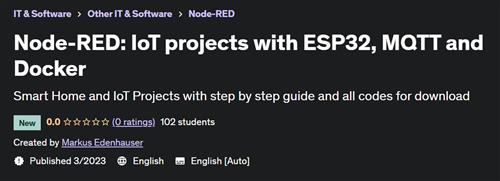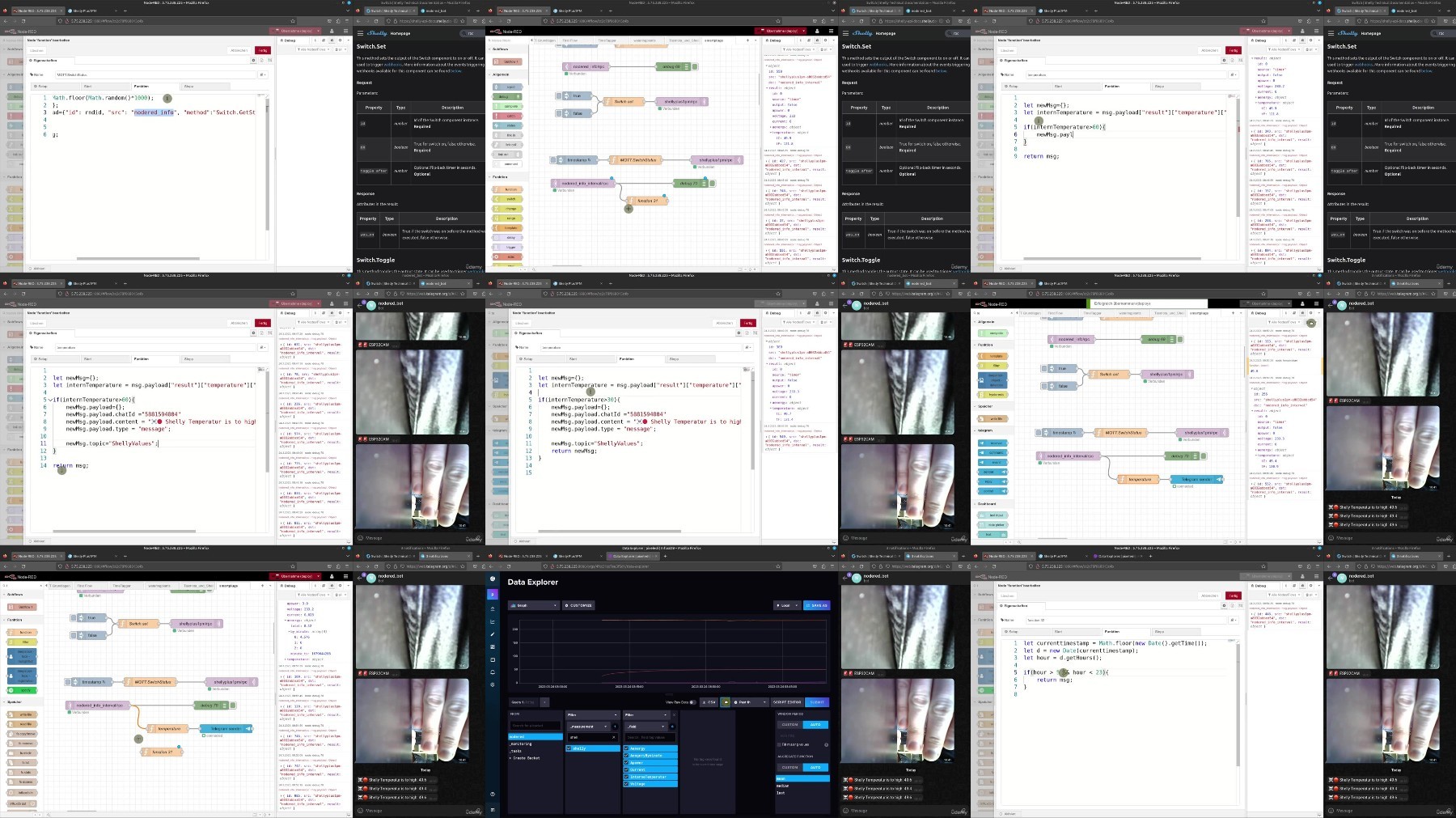Node-Red: Iot Projects With Esp32, Mqtt And Docker
Published 3/2023
MP4 | Video: h264, 1280x720 | Audio: AAC, 44.1 KHz
Language: English
| Size: 7.12 GB[/center]
| Duration: 10h 3m
Smart Home and IoT Projects with step by step guide and all codes for download
What you'll learn
Node-RED Installation and Setup
Mosquitto MQTT Broker, Grafana and InfluxDB as well as MariaDB with Adminer
All microservices are also shown with the Docker variant.
Implementation of ESP32 projects with PlatformIO
Combination of ESP32, MQTT and Node-RED
Creating and programming your own function nodes with JavaScript
State of the Art ESP32 Programming with C++
After this course you will be able to implement your own IoT projects
Requirements
First experience with ESP32
Basic knowledge of C++ and JavaScript
First experience in the Linux world helpful
Be able to build simple circuits.
Description
For Makers and DIY enthusiasts who want to take their Internet of Things (IoT) projects into their own hands.Welcome to my online course on Node-RED, MQTT and ESP32! Designed specifically for Makers and DIY enthusiasts, this course gives you the opportunity to take your projects to the next level by combining Node-RED, MQTT and ESP32.Node-RED is a visual programming environment that allows projects to be created easily and intuitively without the need for in-depth programming knowledge. MQTT is a lightweight protocol for data transmission in IoT networks, with which end devices can be connected quickly and easily. The great advantage of MQTT is that transmission is possible in near real time. The ESP32 is a powerful microcontroller that is ideal for IoT projects thanks to its integrated WiFi and Bluetooth support.In this course you will learn how to use Node-RED to control and regulate your ESP32-based projects and exchange data via MQTT. You will learn how to build your own IoT network, collect data from sensors and visualise it in real time with actual programs like InfluxDB or Grafana. You will also learn how to monitor and control your projects via the internet and retrieve data from anywhere in the world.This course is ideal for Makers and DIY enthusiasts who want to take control of their projects and deepen their knowledge of the Internet of Things with MQTT and Node-RED. The combination of Node-RED, MQTT and ESP32 gives you the flexibility and power you need to turn your projects into reality.What you learn:Node-RED Installation and SetupMosquitto MQTT Broker, Grafana and InfluxDB as well as MariaDB with AdminerAll microservices are also shown with the Docker variant.Implementation of ESP32 projects with PlatformIOCombination of ESP32, MQTT and Node-REDCreating and programming your own function nodes with JavaScriptState of the Art ESP32 Programming with C++After this course you will be able to implement your own IoT projectsSo let's get started and learn how you can create your own IoT projects!Markus Edenhauser, MA MSc
Overview
Section 1: Introduction
Lecture 1 Promo
Lecture 2 About me
Lecture 3 Prerequisites
Lecture 4 Sketch, Code examples and flows
Lecture 5 The basic sketch - start of every project
Lecture 6 Making instead of lecturing
Lecture 7 Disclaimer
Section 2: Install all programmes as containers
Lecture 8 Intro
Lecture 9 Why Docker?
Lecture 10 Get a vServer
Lecture 11 Docker Installation
Lecture 12 Docker CLI using the example of Focalboard
Lecture 13 Portainer
Lecture 14 Mosquitto Broker
Lecture 15 Run Mosquitto in the Container
Lecture 16 ohmyz for more convenient terminal handling
Lecture 17 Mosquitto Broker with PW authentication
Lecture 18 Node-RED
Lecture 19 Node-RED with authentication
Lecture 20 InfluxDB
Lecture 21 Grafana
Lecture 22 MariaDB and create a DB via CLI
Lecture 23 Adminer
Lecture 24 Update Docker Container
Lecture 25 Traefik as reverse proxy for SSL access
Lecture 26 SSL for Node-RED with Traefik Labels
Lecture 27 Cronjobs for backup routines
Lecture 28 Backup of Node-RED Flows via Cronjob
Section 3: First overview of Node-RED
Lecture 29 Intro
Lecture 30 Separation of tasks of software and hardware
Lecture 31 First overview of flow and nodes
Lecture 32 Overwrite Payload with Function Node
Lecture 33 Process JSON
Lecture 34 Context, flow and global variables
Lecture 35 So many nodes
Section 4: MQTT Basics
Lecture 36 Intro
Lecture 37 MQTT terminology
Lecture 38 MQTT network using the example of Subscriber and Publisher
Lecture 39 MQTT Topic Levels and Wildcard with CLI examples
Lecture 40 Quality of Service QoS
Lecture 41 Retained Messages
Lecture 42 Birth Death und Last Will
Lecture 43 MQTT Best Practices
Lecture 44 MQTT Explorer
Section 5: Setup Node-RED
Lecture 45 Intro
Lecture 46 Broker settings and MQTT in & MQTT out
Lecture 47 Save data from Node-RED in InfluxDB
Lecture 48 First visualization of InfluxDB data in Grafana
Lecture 49 INSERT and SELECT with MariaDB
Section 6: Basic sketch with ESP32 for WIFI and MQTT
Lecture 50 Intro
Lecture 51 Recommendation VS Code with PlatformIO
Lecture 52 LED Blink without delay
Lecture 53 WiFi and MQTT Connection
Lecture 54 Switch LED with MQTT
Lecture 55 Send and receive JSON
Lecture 56 Transfer source code from VS Code for Arduino IDE
Section 7: Mini weather station
Lecture 57 Intro
Lecture 58 Wiring
Lecture 59 Basic Sketch
Lecture 60 BMP180 Temperature and barometric pressure
Lecture 61 BH1750 Light sensor
Lecture 62 Transmit sensor data to Node-RED
Lecture 63 Save data in InfluxDB
Lecture 64 Visualize data in Grafana
Lecture 65 Controlling a fan with MQTT
Lecture 66 Control fan with hysteresis
Lecture 67 Temperature values and hysteresis
Section 8: Visualize weather data on the e-ink display
Lecture 68 Intro
Lecture 69 Wiring
Lecture 70 PlatformIO and XIAO ESP32
Lecture 71 E-Ink Hello World
Lecture 72 Align text and adjust font
Lecture 73 Convert and embed graphics
Lecture 74 Display text and graphic together
Lecture 75 Weather data REST API
Lecture 76 Use REST APIs in Node-RED
Lecture 77 JSON editing
Lecture 78 Formatting date and other variables
Lecture 79 ESP32 requests new data
Lecture 80 Deepsleep
Lecture 81 Calculate power consumption
Lecture 82 3D printed housing
Section 9: Surveillance camera with ESP32-Cam incl. Machine-Learning Node
Lecture 83 Intro
Lecture 84 Wiring
Lecture 85 CameraWebServer Example
Lecture 86 Send Picture via MQTT
Lecture 87 Display photos in Node-RED
Lecture 88 Deepsleep and motion sensor as surveillance camera
Lecture 89 Telegram Token and Node-RED implementation
Lecture 90 Save photo on server
Lecture 91 Send photo via Telegram when motion detector is triggered
Section 10: Time recording witht RFID und TimeTagger
Lecture 92 Intro
Lecture 93 Wiring
Lecture 94 Read RFID ID
Lecture 95 Connection to Node-RED
Lecture 96 LED checkin checkout
Lecture 97 TimeTagger as Container with docker-compose
Lecture 98 TimeTagger Web API with HTTP Requests
Lecture 99 PUT Record via WEB API
Lecture 100 Using a Flatfile for saving checkin on server
Lecture 101 Send Record to WEB API
Section 11: Time-controlled plant watering with water level monitoring
Lecture 102 Intro
Lecture 103 Wiring
Lecture 104 Flow Chart
Lecture 105 Basic structure with enums
Lecture 106 MQTT communication with Node-RED and ESP32
Lecture 107 Globals.h for global variables
Lecture 108 Switch on relay via MQTT for 3 seconds
Lecture 109 Evaluate and transmit fill level with ultrasound
Lecture 110 Create MariaDB table and use database node
Lecture 111 Store water level information in MariaDB
Lecture 112 Time interval for watering
Lecture 113 Monitor water tank level
Lecture 114 DeepSleep to save power
Lecture 115 Visualization of data on Dashboard
Section 12: Smart plugs and relays
Lecture 116 Intro
Lecture 117 Flashing Tasmota
Lecture 118 Configure Tasmota
Lecture 119 Switching Tasmota sockets with Node-Red
Lecture 120 Read sensor data from Smart Plug
Lecture 121 Save energy data in InfluxDB and visualize in Grafana
Lecture 122 Shelly 1PM Setup
Lecture 123 Shelly and Node-RED via RPC
Lecture 124 Toggle Shelly with Node-RED
Lecture 125 Relay temperature monitoring with telegram notification
Section 13: Mini IoT Button with 100 days battery life
Lecture 126 Intro
Lecture 127 ESP8266 vs ESP32 XIAO
Lecture 128 IoTButton Sketch and Toggle Node
Lecture 129 3D print and Calculation Battery Consumption
Section 14: Internet Radio
Lecture 130 Intro
Lecture 131 Wiring
Lecture 132 Include Libraries
Lecture 133 Internet radio stations
Lecture 134 Control Radio via MQTT
Lecture 135 Setting the alarm time and Dashboard
Section 15: MQTT with TLS
Lecture 136 Intro
Lecture 137 DynDNS and Certbot
Lecture 138 Mount Cert files in Docker
Lecture 139 mosquitto.conf and NodeRED Broker Settings
Lecture 140 ESP32 and MQTT with TLS
Lecture 141 Analyze MQTT Traffic with Wireshark
Section 16: Conclusion
Lecture 142 Summary of all learnings
Lecture 143 Thank you and see you soon
Anyone with an interest in IoT development,All Makers who want to realise their projects themselves,Developers who are interested in being able to control their own microcontrollers via a dashboard,Anyone who wants to understand, apply and write their own practical projects with microcontrollers.
Free search engine download: Udemy - Node-RED IoT projects with ESP32, MQTT and Docker










